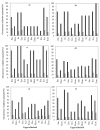Ergot and Ergot Alkaloids in Cereal Grains Intended for Animal Feeding Collected in Slovenia: Occurrence, Pattern and Correlations
- PMID: 33233446
- PMCID: PMC7700445
- DOI: 10.3390/toxins12110730
Ergot and Ergot Alkaloids in Cereal Grains Intended for Animal Feeding Collected in Slovenia: Occurrence, Pattern and Correlations
Abstract
This four-year study reports the occurrence of ergot alkaloids (EAs) in cereals intended for animal feeding collected in Slovenia. A total of 517 samples of cereals were analysed using liquid chromatography-tandem mass spectrometry for the presence of EAs. The sample set included wheat, rye, triticale, oat, spelt and barley. The study revealed that 17% of the analysed cereal samples were contaminated with at least one ergot alkaloid. EAs have two epimeric forms: -ine and -inine. The incidence rates of the -ine and -inine forms in the analysed samples were 16% and 15%, respectively. The highest contamination rates were observed in rye (54%), oat (50%) and spelt (30%), where the highest mean concentrations of total EAs were also determined (502 µg/kg, 594 µg/kg and 715 µg/kg, respectively). However, the highest concentrations of total EAs were found in wheat and rye (4217 µg/kg and 4114 µg/kg, respectively). The predominant EAs were ergometrine, ergosine and ergocristinine. The occurrence of six or more ergot alkaloids was observed in 49% of the positive samples. A weak correlation (p = 0.284) in the positive samples was found between the mass of sclerotia and the total concentrations of EAs using the Spearman correlation coefficient.
Keywords: LC-MS/MS; cereals; correlation; ergot alkaloid occurrence; sclerotia; survey.
Conflict of interest statement
The authors declare no conflict of interest.
Figures








References
-
- European Food Safety Authority (EFSA) Scientific opinion on ergot alkaloids in food and feed. EFSA Panel on Contaminants in the Food Chain (CONTAM) EFSA J. 2012;10:2798–2956.
-
- Buchta M., Cvak L. Ergot alkaloids and other metabolites of the genus Claviceps. In: Kren V., Cvak L., editors. Ergot: The Genus Claviceps. Harwood Academic Publishers; Amsterdam, The Netherlands: 1999. pp. 173–200.
Publication types
MeSH terms
Substances
Grants and funding
LinkOut - more resources
Full Text Sources

